National symbols of India
| Part of a series on the |
| Culture of India |
|---|
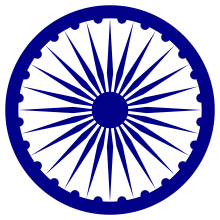 |
| History |
| People |
|
Mythology and folklore |
| Cuisine |
| Religion |
|
Music and performing arts |
| Sport |
|
|
The Republic of India has several official national symbols including a historical document, a flag, an emblem, an anthem, a memorial tower as well as several national heroes. All the symbols were picked up at various times. The design of the national flag was officially adopted by the Constituent Assemblyman just before independence, on the 22nd of July in 1947.[1] There are also several other symbols including the national animal, bird, flower, fruit and tree and game.[2]
National symbols
| Title | Symbol | Image | Notes |
|---|---|---|---|
| National flag | Tiranga |  |
A horizontal rectangular tricolour with equally sized deep saffron at the top, white in the middle and India green at the bottom. In the center is a navy blue wheel with twenty-four spokes, known as the Ashoka Chakra. The flag is based on the Swaraj flag designed by Pingali Venkayya.[1] |
| National emblem | National Emblem of India |  |
An adaptation of Lion Capital of Ashoka at Sarnath was adopted as the National Emblem of India on 26 January 1950, the day India became a republic. Forming an integral part of the emblem is the motto inscribed below the abacus in Devanagari script: "Satyameva jayate" (English: Truth Alone Triumphs), a quote taken from Mundaka Upanishad, the concluding part of the sacred Hindu Vedas.[3] |
| National calendar | Saka calendar | Saka calendar was introduced by the Calendar Committee in 1957. Usage officially started at 1 Chaitra 1879 Saka Era, or 22 March 1957.[4] | |
| National anthem | Jana Gana Mana | 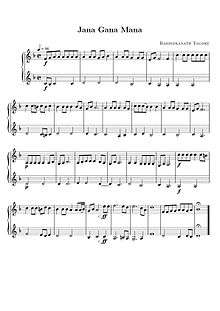 |
Jana Gana Mana by Rabindranath Tagore was officially adopted by the Constituent Assembly as the Indian national anthem on 24 January 1950.[5] |
| National song | Vande Mataram | The first two verses of Vande Mataram by Bankim Chandra Chatterjee was adopted as the National song of India in 1950. "Vande Mataram" was sung during the 1896 session of the Indian National Congress by Rabindranath Tagore.[6] | |
| Oath of allegiance | National Pledge | It was written in Telugu by Pydimarri Venkata Subba Rao in 1962. Central Advisory Board on Education directed that the pledge to be sung in Schools and that this practice to be introduced by 26 January 1965.[7] | |
| National fruit | Mango | .jpg) |
Mango (Mangifera indica) originated in India and the country is home to more than 100 varieties of the fruit.[8] |
| National river | Ganga | 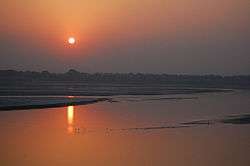 |
Ganga is the longest river of India with the most heavily populated river basin in the world. The river is revered by Hindus as the most sacred river on earth.[9] |
| National flower | Lotus | .jpg) |
Lotus (Nelumbo Nucifera Gaertn) is the National Flower of India. It is a sacred flower and occupies a unique position in the art and mythology of ancient India and has been an auspicious symbol of Indian culture since time immemorial.
India is rich in flora. Currently available data place India in the tenth position in the world and fourth in Asia in plant diversity. From about 70 per cent geographical area surveyed so far, 47,000 species of plants have been described by the Botanical Survey of India (BSI). |
| National tree | Indian banyan | 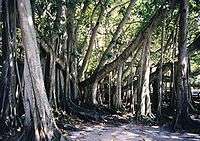 |
Indian banyan (Ficus bengalensis) root themselves to form new trees and grow over large areas. Because of this characteristic and its longevity, this tree is considered immortal and is an integral part of the myths and legends of India.[10] |
| National animal | Royal Bengal tiger | 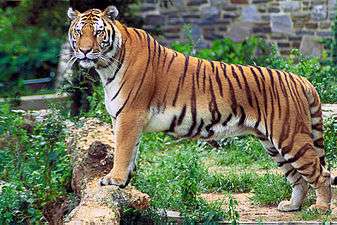 |
The Bengal tiger (Panthera tigris tigris) is found only in the Indian subcontinent and can be found in most regions of the country.[11] |
| National aquatic animal | Ganges river dolphin | 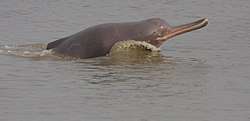 |
The river dolphin is a freshwater or river dolphin found in the Indian subcontinent which is split into two subspecies, the Ganges river dolphin and the Indus river dolphin. The Ganges river dolphin has a sturdy, yet flexible, body with large flippers and a low triangular dorsal fin. It weighs up to 150kg. The calves are chocolate brown at birth and become grayish brown in adulthood with a smooth and hairless skin. Females are larger than males. It can only survive in pure and fresh water.[12] |
| National bird | Indian peacock | Indian peacock (Pavo cristatus) is designated as the national bird of India. A bird indigenous to the subcontinent, peacock represents the unity of vivid colours and finds references in Indian culture.[13] On February 1, 1963, The Government of India have decided to have the Peacock as the national bird of India. The decision has been taken after considering the views of the State Governments and the opinions expressed in the Press.
The question of selecting a national bird has been under consideration since the Tokyo conference of the International Council for Bird Preservation held in May 1960. This matter was taken up by the Indian Board for Wild Life and the State Governments were also asked to give their views. Some of the other birds considered for the honour were the Great Indian Bustard, the Sarus crane, the "Garuda" and the Swan (Hamsa), the strongest contender being the Great Indian Bustard.[14] | |
| National currency | Indian rupee |  |
Indian rupee (ISO code: INR) is the official currency of the Republic of India. The issuance of the currency is controlled by the Reserve Bank of India. The Indian rupee symbol is derived from the Devanagari consonant "र" (ra) and the Latin letter "R" was adopted in 2010.[15]Udaya Kumar Dharmalingam born 10 October 1978 in Kallakurichi, Tamil Nadu is the designer of the Indian rupee sign. His design was selected from among five short listed symbols. According to Udaya Kumar the design is based on the Indian tricolour.
He is an assistant professor at IIT Guwahati. |
| National microbe | Lactobacillus delbrueckii |  |
Lactobacillus delbrueckii (subsp. bulgaricus) has been announced as the National Microbe for India by Jayanthi Natarajan, India's Minister of State for Environment and Forests on October 18, 2012 during the International Conference on "Biodiversity Conservation and Education for Sustainable Development - Learning to Conserve Biodiversity in a Rapidly Changing World" held at Hyderabad during CoP-11. The microbe was selected by children who had visited the Science Express Biodiversity Special, a train which has been visiting various stations across the country. |
| National reptile | King cobra | 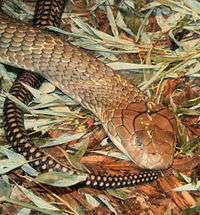 |
King cobra is the national reptile of India. It is consider a sacred animal in Indian culture. They are found almost every part of Indian subcontinent. [16] |
| National heritage animal | Indian elephant |  |
Indian elephant is the national heritage animal of India since October 22, 2010. India's Environment Ministry has declared the elephant a National Heritage Animal in order to increase protective measures for the country's nearly 29,000 elephants."Declaring it the National Heritage Animal will give it due place as emblem of ecological sensitivity. It will also mark recognition for its centrality in our plural cultures, traditions and oral lore," the task force wrote in its report.[17] |
See also
References
- 1 2 "National Flag". Government of India. Retrieved 3 March 2014.
- ↑ "National Identity Elements of India". knowindia.gov.in. Retrieved Jan 2014. Check date values in:
|access-date=(help) - ↑ "State Emblem". Government of India. Retrieved 3 April 2012.
- ↑ "National Calendar". Government of India. Retrieved 3 April 2012.
- ↑ "National Anthem". Government of India. Archived from the original on 15 January 2013. Retrieved 3 April 2012.
- ↑ "National Song". Government of India. Archived from the original on 15 January 2013. Retrieved 3 April 2012.
- ↑ Biswas, Arabinda; Agrawal, S. P. (1 January 1986). Development of education in India: a historical survey of educational documents before and after independence. Concept Publishing Company. p. 140. ISBN 978-81-7022-066-4. Retrieved 27 January 2012.
- ↑ "National Fruit". Government of India. Archived from the original on 22 January 2013. Retrieved 3 April 2012.
- ↑ "National River". Government of India. Retrieved 3 April 2012.
- ↑ "National Tree". Government of India. Archived from the original on 22 January 2013. Retrieved 3 April 2012.
- ↑ "National Animal". Government of India. Archived from the original on 22 January 2013. Retrieved 3 April 2012.
- ↑ "National Aquatic Animal". Government of India. Archived from the original on 22 January 2013. Retrieved 3 April 2012.
- ↑ "National Bird". Government of India. Archived from the original on 15 January 2013. Retrieved 3 April 2012.
- ↑ "This day, That Age Article". The Hindu. The Hindu Newspaper.
- ↑ "Currency Symbol". Government of India. Retrieved 12 November 2012.
- ↑ https://en.m.wikipedia.org/wiki/List_of_national_animals&ved=2ahUKEwjhmrSFuMbcAhUMTI8KHepoBpkQFjACegQIDBAO&usg=AOvVaw0Td1gxXJRLD9MTmm2g9FXC
- ↑ http://www.ens-newswire.com/ens/oct2010/2010-10-22-03.html&ved=2ahUKEwi_oceww8bcAhVLN48KHf3rCewQFjAFegQIAxAB&usg=AOvVaw0AJMDBSYryeFJlO3EZieCg
External links
- National Symbols
- National Symbols Govt. of India Official website.
- National Symbols of India Quiz
| Wikimedia Commons has media related to National symbols of India. |